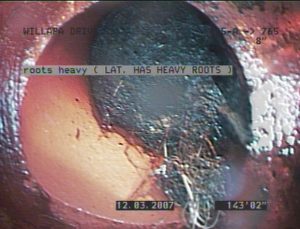Tree Roots – Are You a Victim of the Root Ogre?
Last year, we introduced you to the villainous Grease Monster. This clog-forming monster is created by the grease poured down your drain. This year, we are going to tell you about his partner-in-crime, the Root Ogre. This ogre grabs the grease along with other debris and makes the clogs worse and results in extreme pain in our wallets.
Roots thrive in the warm, moist, nutrient-rich atmosphere above the water level inside sanitary sewers. The flow of warm water inside the sewer pipe causes water vapor to escape to the cold and/or dry soil surrounding the pipe. Tree roots are attracted to the water vapor leaving the pipe and they follow the vapor trail to the source of the moisture, which is usually from cracks or loose joints in the sewer pipe. Tree roots will penetrate the opening to reach the nutrients and moisture inside the pipe. This continues in winter even though trees appear to be dormant. Once inside the pipe, roots will continue to grow and if not disturbed, they will completely fill the pipe with many hairy root masses at each point of entry. The network of roots grows, forming a nasty ogre inside the pipe, trapping grease, tissue paper, and other debris discharged from the residence or business. Homeowners will notice the first signs of a slow flowing drainage system by hearing gurgling noises from toilet bowls or drains become slower when emptying their tubs. A complete blockage will occur if no remedial action is taken to remove the roots and resulting blockage.
As roots continue to grow, they exert considerable pressure at the crack or joint where they entered the pipe. The force exerted by the root growth can break the pipe and may result in total collapse of the pipe. Severe root intrusion and structurally damaged pipes will require replacement. Tree roots growing inside sewer pipes are generally the most expensive sewer maintenance item experienced by Township residents. Roots from trees growing on private property throughout the Township sewer areas are responsible for many of the sanitary sewer backups and damaged sewer pipes. Homeowners should be aware of the location of their building sewer and refrain from planting trees, bushes, and hedges near the building sewers. You may want to consult tree experts and ask their advice. The replacement cost of a building sewer line as a result of damage from tree roots can be very expensive.
How can you determine if you are a likely victim of the Root Ogre? If your home was built before 1980, you may have clay or iron pipes. These pipes are more likely to have cracks or joint problems caused by ground settling or freeze/thaw cycles than PVC pipes. Look at your yard and walk above the area where your building sewer is located. Walk with a person on each side of you, holding hands with your arms stretched out wide. If anyone bumps into a tree or large bush before you get to the street or sewer main, you may be visited by the Root Ogre.
Other than removing the trees or replacing the building sewers with PVC pipe, there isn’t any permanent solution. If the blockage is bad, the roots have to be cut and flushed away. The foam-type aquatic herbicide can be added a couple weeks later. The foaming herbicide fills the pipe, killing the roots on the top of the pipe as well as the sides. Annual use usually will keep them from returning. Please do not use any copper sulfate type root-killer. The copper crystals will only affect roots on the bottom of the pipe, and since roots are found in the top of the pipe, above the water level, only a tiny part of the root problem will be affected. Also, the copper will end up at the plant and may adversely affect the sludge treatment process and cost the municipality and you more money.
If your plumber has to cut out roots from your building sewer, please call 292-3634 and let us know. We will send a crew to make sure that the roots the plumber cut out do not cause problems for your neighbors downstream.

Landscape & Plant wisely!
Beautifully landscaped yards can be a joy to homeowners that can turn into expensive nightmares. Roots from trees can invade building sewers and laterals. Roots thrive in the warm, moist, nutrient-rich atmosphere above the water level inside sanitary sewers. The flow of warm water inside the sewer pipe causes water vapor to escape to the cold and/or dry soil surrounding the pipe. Tree roots are attracted to the water vapor leaving the pipe and they follow the vapor trail to the source of the moisture, which is usually from cracks or loose joints in the sewer pipe. Tree roots will penetrate the opening to reach the nutrients and moisture inside the pipe. This continues in winter even though trees appear to be dormant. Severe root intrusion and structurally damaged pipes will require replacement. Tree roots growing inside sewer pipes can become a costly problem for township residents.
The best way to avoid this situation is to plant wisely. Do not plant trees within 20 feet from any building sewer, lateral, or sewer main. That small little twig that you plant today can grow into a big tree in a few years. Roots can travel far underground, across property lines and under paved roads. Minimize future problems by planning and planting wisely. In Pennsylvania, homeowners and contractors are required to contact PA OneCall, by dialing 8-1-1 at least three business days before beginning any digging or excavation project. Go to www.paonecall.org for more information.
More Sanitary Sewer Information




